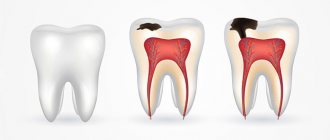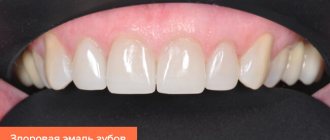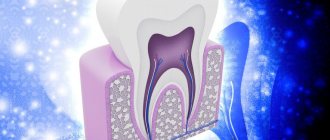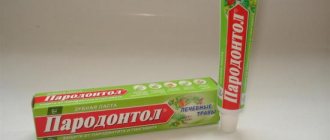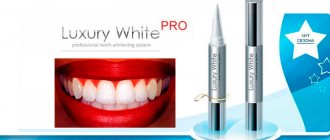Tooth enamel is the outer shell of human teeth, designed to protect dentin and pulp from harmful environmental influences. The enamel layer is the most durable tissue in the modern human body, however, it is also quite susceptible to destruction under the influence of adverse factors. Over time, tooth enamel becomes porous, thin and gradually loses its protective functions. That is why modern dentists urge patients to pay increased attention to dental care and take all possible measures aimed at strengthening them.
One of the methods that allows you to restore the structure of the enamel layer and protect it from destruction is fluoridation of teeth .
What it is?
The essence of the procedure is preliminary cleaning of the oral cavity with alternate treatment with the first and second composition
The progressive demineralization of tooth enamel from the aggressive action of acids and the development of caries can be protected by using deep fluoridation.
To carry out the procedure, it is recommended to use enamel sealing liquid, which contains a strong mineral complex and has an effective restorative effect.
When applying the product to the surface of the teeth, the active components of the first composition penetrate into the pores, filling the voids, and the substances of the second fix the achieved result by sealing.
The essence of the procedure is preliminary cleaning of the oral cavity (teeth and mucosal surface) with alternate treatment with the first and second composition.
Fluoride, when combined with highly dispersed calcium hydroxide, provides deep fluoridation of the enamel structure, that is, it makes the tissue of the tooth neck hard. The session ends with mouth rinsing.
Benefits of deep fluoridation
The main advantages of deep fluoridation are:
- reduction in the incidence of caries by 65%;
- improving the structure of the enamel layer;
- significant reduction in tooth sensitivity;
- tenfold increase in the density of tooth enamel;
- reducing the risk of developing secondary caries;
- increasing the service life of previously placed fillings;
- quickly normalize the condition of the oral mucosa and gum tissue.
It has been proven that the effect of deep fluoridation lasts for 11 months after the end of the preventive course. However, this does not mean that this procedure provides complete protection of teeth from caries and other dental pathologies. Both deep and superficial fluoridation can only reduce the risk of developing diseases and increase the resistance of enamel to the action of destructive environmental factors. In order to ensure comprehensive dental protection, sufficient attention should be paid to all existing preventive measures.
Indications for use
The sealing composition is recommended for use for the following purposes:
- The deep fluoridation procedure is prescribed after removal of braces and a large accumulation of yellow plaque near the gums
to prevent the development of caries and treat lesions;
- when carrying out mineralization of fissures;
- for the prevention of other (non-carious) lesions of the enamel structure;
- to reduce the sensitivity of the neck of the tooth;
- after teeth whitening.
The deep fluoridation procedure is prescribed after the removal of braces, a large accumulation of yellow plaque near the gums, as well as pain that occurs when performing oral hygiene procedures.
What is enamel fluoridation?
Fluoridation is one of the methods of tooth remineralization, which involves saturating the enamel with fluoride particles.
The beneficial properties of fluorides were first discussed in 1940, when the American scientist Basil Bibby managed to prove that fluoride helps restore and maintain the normal structure of the dentin and enamel layer, prevent the development of caries and other dental diseases, increase the resistance of teeth to harmful factors and slow down the process of destruction enamel.?
These days, fluoridation can be done in most dental clinics around the world. At the same time, artificial enrichment of tooth enamel with fluoride can be both superficial and deep.
Composition of the drug
The sealing liquid complex includes two liquids (usually 20 ml each):
- for primary processing;
- for the final one.
The preparation for primary treatment contains: anhydrous magnesium fluoride silicate, anhydrous copper fluoride silicate-||, sodium fluoride (functions as a stabilizing component), distilled water.
The composition of the second solution includes: highly dispersed calcium hydroxide, methylcellulose, distilled water.
The operating principle of the product is based on the properties of the active components:
- the ability to inhibit the process of enamel demineralization;
- remineralization of defects with high concentrations of fluoride ions;
- bactericidal effect due to the content of copper ions;
- attachment of hydroxyapatite microcrystals to collagen with the participation of copper ions, which ensures “self-assembly” of the tissue;
- increasing the resistance of teeth to carious influences, which is achieved thanks to magnesium ions.
Step-by-step instructions for use
A properly performed procedure ensures a high-quality result from the use of sealing enamel.
Deep fluoridation of teeth is performed in the following sequence according to the instructions:
- A properly performed procedure ensures a high-quality result from the use of sealing enamel
The dentist examines the oral cavity, determines the condition of the enamel and soft tissues.
- Plaque is removed from the surface with a toothbrush and special cleaning agents.
- The teeth are dried under the influence of warm air.
- Liquid No.1 is applied to a cotton pad. Next, the teeth are carefully processed.
- The next step is to wet the tooth surface with liquid No2 using a cotton swab. In this case, there is no need to carry out intermediate rinsing of the mouth.
- The procedure is completed by thoroughly rinsing the mouth.
At the end of the session, the patient is asked to sit in a chair with his mouth open for about 5-7 minutes. This is necessary for reliable fixation of the composition with the enamel.
When should you see a doctor?
- increased sensitivity of teeth,
- pain when brushing teeth, eating solid foods,
- acute discomfort due to exposure to any irritants - hot, cold or spicy food,
- uneven enamel surface - the presence of chips, cracks, roughness and even depressions,
- discoloration of enamel - when it becomes thinner, dark dentin shows through,
- congenital or acquired enamel hypoplasia.
Strengthening teeth: 5 reliable methods
Expert opinion
Elina Ruslanovna Dzagurova Dentist-therapist Work experience 9+
“Our center practices an integrated approach, because it is the combination of several techniques that can significantly reduce tooth sensitivity and strengthen tooth enamel. The patient himself needs to do a lot of work – be sure to monitor his diet and use the right hygiene products.”
Enamel remineralization
Remineralization of teeth is the restoration of the mineral composition of tooth enamel, for which special medicinal compositions are used. They are applied to the teeth (including using mouth guards) and held for several minutes. A number of drugs are activated by exposure to ultraviolet light or electrophoresis (electrical pulses). The course of such treatment and prophylactic procedures can last from 3-4 to 20 days. Before they are performed, careful removal of plaque and tartar is required.
For remineralization, Apadent Pro paste with nano-hydroxyapatite is considered one of the most effective preparations, which allows you to restore the structure of teeth in the presence of foci of demineralization, including superficial caries.
Fluoridation of enamel
Fluoridation differs from remineralization only in the composition of medicinal preparations. In this case, gels and ointments are also used, which are applied to the outer surface of the teeth. However, most of their composition is occupied by fluorine and calcium, which significantly strengthen the enamel, making it stronger and more resistant to external influences.
Proper hygiene
The patient himself needs to more carefully monitor his oral hygiene and be sure to change his dental care products. The general rules are that the brush should not be too hard (during the period of exacerbation, you can change it to a soft one, but not for long - it will not cope with plaque). When brushing your teeth, do not put too much pressure on your teeth - this leads to trauma to the enamel.
During the period of weakening of the enamel, you should choose special pastes that reduce tooth sensitivity. However, you do not need to use them constantly - 1-2 times a year for a month.
Proper nutrition
The process of remineralization of enamel can be carried out at home - all you need to do is change your diet. Milk and fermented milk products (cheese, yogurt, kefir), greens, strawberries (contain a large amount of vitamin C), green tea will be useful. You should consume as many foods as possible that contain calcium1 - it helps strengthen tooth enamel.
You can take calcium in the form of medications 1-2 times a year. However, do not forget about the simultaneous intake of vitamin D, which promotes the absorption of calcium and fluoride in our body.
Dental restoration
Dental restoration is an extreme measure that is used in case of hypoplasia or destruction of tooth enamel, because the internal tissues of the tooth may be exposed. In this case, it is extremely necessary to protect them from external irritants. The most reliable option would be to install veneers and lumineers - thin overlays on the front surface of the teeth, which allow you to change the shade, align the position of the teeth, transform their appearance and, of course, protect the enamel from negative external influences.
Application
For the prevention of caries through deep fluoridation (mineral sealing of enamel)
Before the procedure, the teeth should be cleaned with a toothbrush, the spaces between the molars and incisors should be carefully worked with a special thread.
Before the procedure, your teeth should be cleaned with a toothbrush, and the spaces between the molars and incisors should be carefully worked with a special thread.
Next, drying is performed using a warm air stream, after which the teeth are treated with a swab moistened in liquid No. 1 for 5 minutes.
Without rinsing your mouth, treat the surface with liquid No2 in the same way. After a couple of minutes, the patient is asked to rinse his mouth.
Deep fluoridation for the purpose of caries prevention is carried out 1-2 times a year. The mechanism of action of the active components is to fill pores and microcracks with subsequent tissue remineralization.
In the course of the studies, the majority of patients showed positive results in the restoration of tooth enamel.
For mineral sealing of fissures
The procedure is carried out in the same way as for the prevention of caries on fissures that have been previously cleaned of plaque. The active substance used for sealing is water-containing silica.
The mineral composition works extremely gently, without expanding the hard structure of the fissures or having minimal impact on them.
Due to the content of calcium fluoride in the composition, prolonged remineralization is ensured with the participation of saliva. Repeated treatment is carried out after 8-12 months.
SCHMEIZ-VERSIEGELUNDSLIQUID prevention and treatment of caries; fissure sealing; desensitization of the tooth neck; treatment of periodontitis (5 ml + 5 ml)
Instructions for use:
- Enamel-sealing liquid / Tifenfluoride
- (Schmelz-Versiegelungsliquid / Tiefenfluorid)
- Preparation No. 1: 5 ml of liquid for the first treatment
- Preparation No. 2: 5 ml of liquid for the second treatment
Composition of preparation No. 1: anhydrous magnesium fluoride silicate, anhydrous copper fluoride silicate-||, sodium fluoride (as a stabilizer), distilled water.
Composition of preparation No. 2: highly dispersed calcium hydroxide, methylcellulose, distilled water.
Indications for use: for desensitization of the tooth neck by deep fluoridation of the hard substance, for optimal local caries prevention, for mineral sealing of fissures.
Properties: Tifenfluoride in combination with highly dispersed calcium hydroxide, applied sequentially one after the other to the hard substance of the tooth, provides deep fluoridation of the enamel or hard substance of the tooth neck.
Deep fluoridation, in contrast to conventional fluoridation, refers to the formation of submicroscopic CaF2 crystals inside the pores of loosened enamel. Submicroscopic CaF2 consists of particles with a size of only 50 A. They arise along with magnesium fluoride particles and silicic acid gel after wetting the enamel or osteocement with Tiefenfluoride and subsequent wetting with calcium hydroxide. Unlike the rather large CaF2 crystals that form on the surface of the enamel during the usual treatment of a hard substance with simple fluorides, for example, sodium fluoride, submicroscopic crystals that appear when treating a tooth with Tifenfluoride are located deep in the pores (about 7) of the loosened enamel. Packed in a gel and thereby protected from mechanical stress, they constantly release fluoride, which, together with the mineral salts of saliva, ensures long-term remineralization, enhancing it almost 100 times.
Directions for use:
Desensitization of the tooth neck: Remove plaque with a toothbrush and dry the teeth relatively with warm air. Then the neck of the tooth is generously moistened with a cotton swab soaked in preparation No. 1 for 1/2 a minute. Do not rinse your mouth! Then thoroughly moisten with preparation No. 2 (shake thoroughly beforehand). Only after this can the patient rinse his mouth. After the procedure, there is no need to dry the surface of the teeth. The patient can eat food immediately. Subsequently, the procedure is recommended to be carried out 1-2 times a year.
Prevention of caries through deep fluoridation (mineral sealing of enamel):
The teeth are thoroughly cleaned with a toothbrush. The interdental spaces are cleaned with dental floss or special interdental brushes. After relative drying with a stream of warm air, the teeth are treated quadrant by first with liquid No. 1 (swab or brush) for % min. Do not rinse your mouth! Then they are treated in the same way with liquid No. 2 (pre-shake the contents). After this, you can rinse your mouth with water. Immediately after the procedure, the patient can eat. Carry out the procedure 1-2 times a year.
Mineral fissure sealing: Tifenfluoride provides highly effective mineral fissure sealing, preserving tooth tissue as much as possible.
This occurs as a result of increased remineralization processes with the participation of saliva due to deep fluoridation, as well as due to the oligodynamic effect of copper ions.
With this technology, fissures, which are usually coated with polymer compounds, are covered with a thin layer of a mineral substance (water-containing silicon oxide). The calcium fluoride it contains ensures strong long-term remineralization with the participation of saliva. The effect is provided for more than 1 year.
Exclusively minimal, hard substance-sparing fissure expansion is performed, or dispensed with without expansion at all. Dry with warm air and thoroughly moisten with preparations, as described above for the prevention of caries. In the future, the procedure is repeated 1-2 times a year as part of the prevention of caries through deep fluoridation.
Directions: If a large amount (more than 5 ml) of Tifenfluoridagan (liquid No. 1) is accidentally swallowed, drink plenty of water or milk. The doctor's office recommends using liquid gypsum milk (1 teaspoon per 1 cup of water) as an antidote.
Tifenfluoride, unlike simple fluorides, such as sodium fluoride, due to the subsequent application of calcium hydroxide, does not have a toxic effect.
For ease of dosing, the caps on the bottles can be replaced with the included pipettes (labeled blue for liquid No. 1, white marked for liquid No. 2).
Contraindications and side effects: none.
Expiration date: indicated on the packaging. After the expiration date, drugs cannot be used.
Effect
After treating the teeth enamel with a sealing liquid, there is a decrease in hypersensitivity to temperature changes and sweets
After treating the enamel with a sealing liquid, the hardness and strength of the tooth enamel significantly increases, which reduces the risk of caries.
There is also a decrease in hypersensitivity to temperature changes and sweets. The achieved coating result lasts up to a year.
The achieved effect can be extended if you follow simple rules:
- reduce sugar consumption, it is recommended to replace refined sand with fructose;
- sweets that destroy tooth enamel should be replaced with fruits, dried fruits, and nuts;
- after each meal you need to brush your teeth with a special floss and rinse with balm;
- morning and evening, perform oral hygiene procedures using high-quality toothpaste and a properly selected brush.
Contraindications
The use of zmal sealing liquid for deep fluoridation is prohibited in the following cases:
- in the presence of viral and colds;
- allergies to one of the components included in the composition;
- if diabetes mellitus is diagnosed;
- when the level of fluoride in the body exceeds the norm.
Pregnancy is not a contraindication. The procedure is performed locally, without posing a threat to the fetus and the woman’s overall health.
Dentin enamel sealing liquid tiefenfluorid
The drug Tiefenfluorid is effective for sealing fissures - natural depressions on the teeth that perform the function of chewing food.
During the procedure, active substances fill the voids in the pores where the combination of calcium copper hydroxide and fluoride silicate complex occurs.
As a result, tiny crystals of calcium fluoride and silicic acid gel are formed.
When they penetrate into the pores of the loosening structure of the enamel, they contribute to the accumulation of fluoride ions, resulting in the formation of a high degree of saturation with a valuable microelement. This method exceeds the use of fluoride-containing pastes by five times.
This method is recommended for patients who are forced to wear orthopedic structures, as well as for children aged 10-12 years who have defects in the dental structures.
Enamel sealing liquid humanchemie
The drug is intended to prevent the development of caries and restore the enamel structure.
The product has high bactericidal activity, prevents the formation of microbial biofilm on the surface of the teeth, and protects the pulp and dentin from microorganisms.
The enrichment of the enamel structure with essential minerals is achieved through the inclusion of copper ions in the composition of the preparation.
Sealing damage to primary teeth with liquid enamel
In the children's department of the Yabloko MC, children from zero to older are observed, and each age category of young patients is provided with careful attention and professional assistance. Caring for the health of the child is common to all loving parents.
We remind all mothers and fathers that the full development of the whole organism is impossible without the correct development of temporary (“baby”) and permanent teeth.
Everything that happens to a baby, preschooler, or teenager requires attention.
Children's dentistry.
At the appointment, the doctor determines the hygiene index of the child’s oral cavity by: You will see colored plaque - these are the areas where plaque accumulates the most. Then the doctor will remove plaque, polish the surface of the teeth with professional pastes, select oral care products, tell and show how to brush your teeth correctly.
Fissure sealing
Fissures are folds and indentations on the surface of the enamel. Each person has a different fissure pattern, but a common feature is the ability of plaque to get stuck in the folds of the enamel. Microorganisms in the oral cavity, processing plaque, form acid that corrodes the tooth. This is how caries occurs. This can easily be avoided by sealing the fissures. It is very important to carry out such a procedure in the early stages after tooth eruption, since during this period the enamel is poorly mineralized and, therefore, more susceptible to caries. The fissure is sealed using liquid enamel.
“Enamel-liquid” is a drug that protects a newly erupted tooth, as well as a tooth that already has damage in the form of a “chalky stain” from the effects of plaque, food acids, and carbohydrates. The particles of this substance are so small that they penetrate the enamel structure, creating a protective film that lasts for six months.
The treatment procedure with “Enamel-liquid” is very simple:
The tooth is cleaned of plaque, and then covered with the “Enamel-liquid” preparation using a brush or cotton ball. Processing time - 2 minutes. The course of treatment should be at least two years (four procedures every six months) subject to good oral hygiene.
“Dentin-liquid” is a drug that is applied to the dentin of a tooth that is already stained with caries. It strengthens dentin and cleanses it of microbes. Thanks to treatment with this drug, further destruction of tooth tissue can be prevented. In cavities that cannot be filled, the destruction process is suspended. The processing procedure is identical to the previous one and takes two to three minutes. Typically, in young children with multiple destruction of tooth enamel, two sessions are used with an interval of 7-10 days.
This technique can be replaced by “silvering” the teeth . This is an alternative to deep fluoridation. But this technique has a significant drawback: silver stains the tooth tissue in a dark color . A repeat course is carried out in this case after three months.
Price
The cost of the drug depends on the volume of bottles with working fluids and the manufacturer.
For example, Enamel-sealing liquid (20g+20g) from the HumanChemie brand can be purchased at a price of 4,298 rubles.
The cost of one deep fluoridation procedure in a dental center will cost approximately 3,000 – 3,400 rubles.
At the same time, it includes: cleaning the oral cavity, polishing the teeth using a special paste and brush, applying an enamel sealing liquid.
Surface fluoridation of teeth
Surface fluoridation of teeth is a set of simple and painless dental procedures that involve enriching dental tissues with fluoride using special gels or varnishes.
In the first case, an individual dental tray filled with sodium fluoride or another fluoride-containing drug is used for remineralization. The device is carefully placed on the patient’s teeth and held on them for about a quarter of an hour. To achieve the desired effect, the procedure is carried out 3 times in a row with an interval of 2 days.
Stages of surface fluoridation
In turn, fluoridation of teeth using fluoride varnish is carried out in several stages and involves:
- cleaning the enamel layer from deposits;
- drying the surface layer of teeth with warm air;
- applying fluoride-containing varnish to the enamel using a special brush or a ball of sterile cotton wool (the upper row of teeth is initially treated, and then the lower row);
- drying the varnish.
After completing the procedure, the patient is advised to stop eating solid foods and brushing his teeth for a day. To achieve a lasting result, the varnish is applied to the enamel surface several times with an interval of 2 days. A second course of fluoridation may be required no earlier than after 7 months.


